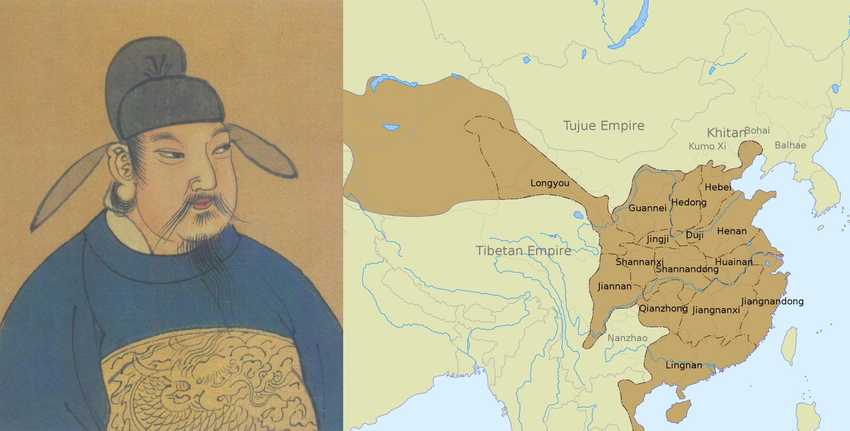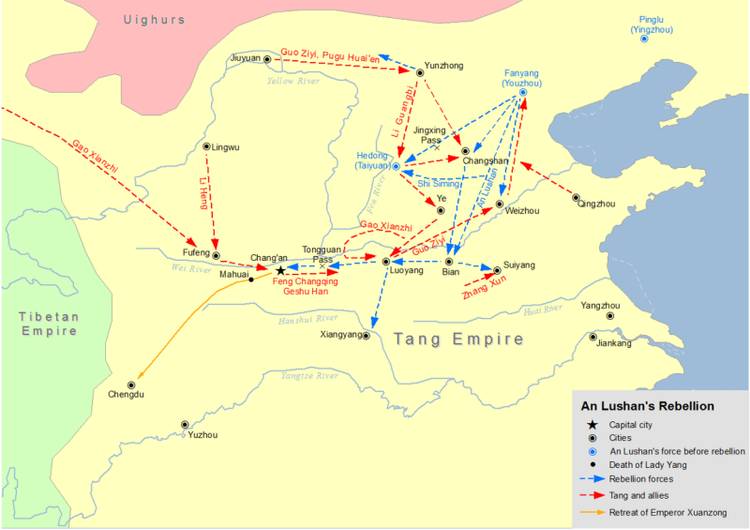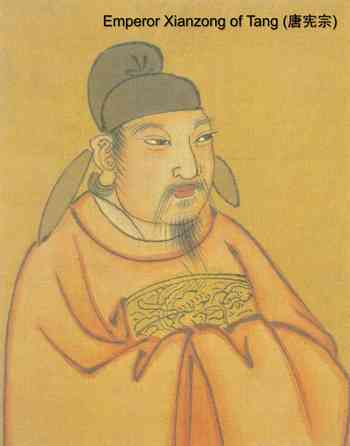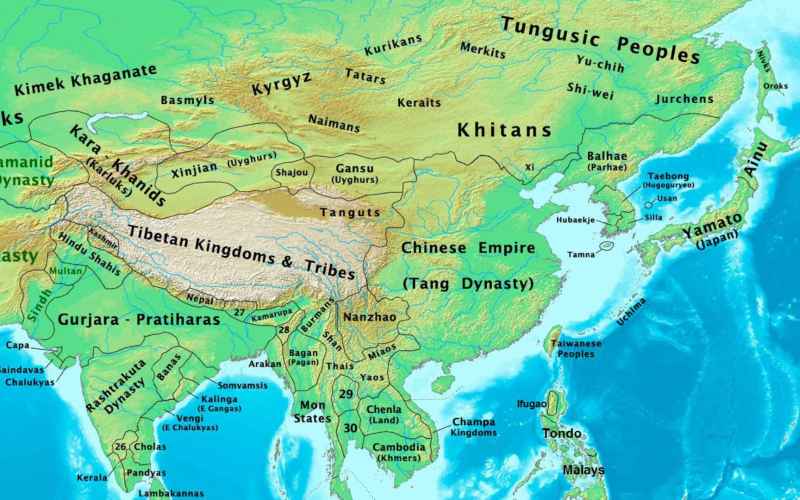Chinese Dynasty: Tang Dynasty's Unforgettable Triumphs and Tragedies
Established in 618 CE by Li Yuan (李渊), Emperor Gaozu of Tang (唐高祖), the Tang Dynasty (唐朝, Táng) lasted for almost three hundred years and saw the height of Chinese culture, trade, economy, society, and influence over the world.
As we've mentioned in the last article on the history of Tang from its establishment to Wu Zhou (武周), it also had the first and only female emperor Wu Zetian (武则天) in Chinese history.
In this article, we will go over the rest of the Tang Dynasty's history from the end of the Wu Zhou era to the end of Tang.
Restoration of Li's Tang
After Wu Zetian (武则天) was forced to abdicate in 705 CE, Emperor Zhongzong (唐中宗) was restored to the throne. However, Emperor Zhongzong was heavily influenced by his wife, Empress Wei (韦皇后), his daughter, Princess Anle (安乐公主), and the Wu clan faction led by Wu Sansi (武三思), engaging in corruption, bribery, and extravagant lifestyles. Empress Wei aspired to become another Wu Zetian, and Princess Anle sought to be the Crown Princess.
In 707 CE, Li Chongjun (李重俊), who was the Crown Prince but not Empress Wei's biological son, led a coup, resulting in the death of Wu Sansi but failed to harm Empress Wei.
In 710, Empress Wei and Princess Anle conspired to poison Emperor Zhongzong, made Li Chongmao (李重茂) emperor, and attempted to harm Li Dan (李旦, Emperor Ruizong, reigned once 684-690 under Wu Zetian's control), who was excluded from power.
However, Li Dan's third son, Li Longji (李隆基), supported by Princess Taiping (太平公主), Wu Zetian's daughter, initiated the Tang Long coup (唐隆政变) in the same year, eliminating Empress Wei, Princess Anle, and the remaining Wu faction. Li Chongmao was deposed, Li Dan was restored to the throne as Emperor Ruizong, and Li Longji was made the Crown Prince.
After Emperor Ruizong's restoration, corruption continued in the court. Princess Taiping gained significant power and most of the officials and ministers supported her, leading to intense conflicts between Princess Taiping and Crown Prince Li Longji.
Reign of Kaiyuan (开元之治)

Left: a portrait of Emperor Xuanzong of Tang. Right: Tang territories and provinces by 742 CE.
In 712 CE, Emperor Ruizong abdicated in favor of his son, Li Longji, who became Emperor Xuanzong (唐玄宗). Emperor Xuanzong took swift action to end the influence of Princess Taiping and her followers, restoring stability after years of turmoil since Emperor Zhongzong's reign (705-712 CE).
During his reign, Emperor Xuanzon focused on reforming various aspects of governance.
Politically, Xuanzong promoted capable officials, reformed corrupt governance, and established a supervisory system, streamlining the bureaucracy and reducing redundant officials. He also developed the system of regional military governors, increasing local power. In 723 CE, he reestablished Taiyuan (太原) as a secondary capital outside the two main capitals, Chang'an (长安, now Xi'an) and Luoyang (洛阳).
Economically, Xuanzong advocated frugality, curbed Buddhism's influence, and revitalized the system of state granaries. He also addressed land consolidation issues through measures like household registration.
Militarily, he transitioned from a system of soldiers under the central government to a recruitment system, revived horse administration, and reclaimed territories like Yingzhou in Liaoxi (辽西营州) and the Hexi Corridor (河西九曲) granted to Tibetan Empire (吐蕃) during the reign of Emperor Ruizong. He also subjugated various other polities, including the Khitans (契丹), Shiwei (室韦), Mohe (靺鞨), and the Second Turkic Khaganate (后突厥). In the Western Regions (西域), he annexed various regions and defeated part of the Western Turkic Khaganate.
Emperor Xuanzong's reign lasted for 45 years (712-756 CE). Under his rule, the Tang Dynasty reached unparalleled strength and prosperity, often referred to as the Golden Age of Kaiyuan (开元盛世).
An Lushan Rebellion (安史之乱)

Paintings of Yang Yuhuan by Hosoda Eishi (left) and Emperor Xuanzong's Journey to Sichuan by Qiu Ying (right)
During the later years of Emperor Xuanzong's reign, the Tang Dynasty experienced prolonged peace, leading to Xuanzong's loss of ambition for progress and a focus on indulgence and pleasure, particularly after he made Yang Yuhuan (杨玉环) his Guifei (贵妃, the highest rank for imperial consorts at the time). The appointment of the cunning Li Linfu (李林甫) as prime minister further worsened the state of affairs, and the influence of Yang Yuhuan's family and eunuch Gao Lishi (高力士) created more instability.

Map of military movements during the An Lushan Rebellion
Emperor Xuanzong's desire for military glory led to frequent border conflicts, and the implementation of a recruitment system that tied military commanders with soldiers, which culminated in An Lushan (安禄山), a powerful general with control over troops, launching the An Lushan Rebellion (or An-Shi Rebellion, 安史之乱) with Shi Siming (史思明) in 755 CE.
The following year, the rebellion army invaded Luoyang and Emperor Xuanzong fled to Chengdu (成都) while his son Li Heng (李亨), known as Emperor Suzong (唐肃宗), established himself as emperor in Lingwu (灵武). In the meantime, An Lushan proclaimed himself Emperor of Yan Dynasty (大燕皇帝) in Luoyang.
The rebellion continued for eight years (755-763 CE), causing significant damage to Tang's strength and leading to a sharp decline in population, as well as a decline in central authority and the rise of regional military governors. Emperor Suzong passed away in 762 CE, and his son Li Yu (李豫) succeeded the throne as Emperor Daizong (唐代宗), who finally defeated the An Lushan Rebellion in 763 CE. However, the damage caused by the conflict weakened the Tang Dynasty, leading to the strengthening of regional military powers and the gradual disintegration of central authority.
Emperor Daizong ruled during a turbulent time, facing the An Lushan Rebellion and struggles with regional warlords. He implemented reforms to improve the country's finances and shifted the tax system to focus on property rather than the population, which was called the Two-Tax Law (两税法, a semiannual taxation system). However, this tax reform didn't go far. His successor Li Shi (李适), Emperor Dezong (唐德宗), finally implemented the Two-Tax Law in 780 CE.
During his reign, Emperor Dezong continued to face challenges from regional powers, leading to compromises and further fragmentation of the empire. However, he also formed alliances to combat external threats, creating a more favorable environment for future restorations.
Yuanhe Restoration (元和中兴)

A portrait of Emperor Xianzong of Tang
In 805 CE, Emperor Dezong passed away, and his son Li Song (李诵) succeeded him as Emperor Shunzong (唐顺宗). However, due to his poor health, Shunzong's reign lasted less than 200 days, during which he attempted reforms that upset the eunuchs and regional warlords, forcing him to abdicate in favor of his son, Li Chun (李纯), who became Emperor Xianzong (唐宪宗).
Emperor Xianzong loved to read historical records and learned from wise emperors of the past, he valued the role of his ministers and fearlessly appointed capable and virtuous advisors. During his 15-year reign, he achieved notable political reforms and accomplishments.
In military matters, Emperor Xianzong aimed to strengthen his rule by dealing with powerful regional warlords. With the support of his advisors, he subdued rebellions in the western regions, pacified the rebellious Wu Yuanji (吴元济) in Huai Xi Zhen (淮西镇), and gained the submission of other regional leaders. The Tang Dynasty achieved temporary unity during this period, known as the Yuanhe Restoration (元和中兴, 805-820 CE).
However, in 821 CE, while regions in Henan (河南), Hebei (河北), and Shandong (山东) continued to remain under the control of the central government, a few regional powers including Wei Bo (魏博), Cheng De (成德), and You Zhou (幽州) revolted again, and the issue of regional warlords persisted.
Eunuch and Party Struggle
During the late Tang Dynasty, external threats from the Tibetan Empire (吐蕃) intensified, while internal issues also deepened. Eunuchs gained excessive power during the reign of Emperor Suzong (唐肃宗, reigned 756-762 CE), controlling the Shence Army (神策军). Subsequent emperors, including Emperor Daizong (唐代宗, reigned 762-779 CE), were either chosen or influenced by eunuchs.
This period also saw the emergence of factional strife at the court, particularly between the "Niu Party" and the "Li Party," led respectively by Niu Sengru (牛僧孺) and Li Deyu (李德裕). The eunuchs capitalized on this rivalry, further consolidating their power. In 835 CE, Emperor Wenzong (唐文宗) attempted to restrain eunuch influence but failed. His successor, Emperor Wuzong (唐武宗, reigned 840-846 CE), successfully curtailed the power of eunuchs through distant approaches and decisive actions.
A Brief Revitalization

A late Tang mural from Mogao cave commemorating the victory of General Zhang Yichao over the Tibetans in 848 CE
Emperor Wuzong (唐武宗) further expanded Tang territory through military successes against external threats and subdued internal rebellions. He also favored Daoism and launched an anti-Buddhist campaign known as the Huichang Persecution of Buddhism (会昌灭佛) which enhanced the central government's authority but incurred economic losses.
In 846 CE, Emperor Wuzong died, and Emperor Xuanzong (唐宣宗, not the same as 唐玄宗, also Emperor Xuanzong in English) succeeded him. Xuanzong surprised everyone by showing determination to govern effectively, curbing eunuch power, and emphasizing talent selection.
In 848 CE, a rebellion led by Zhang Yichao (张议潮) in Dunhuang (敦煌) expelled Tibetan (吐蕃) forces from the Hexi region. After years of struggle, the eleven prefectures in the Hexi Corridor (河西走廊) returned to Tang control, completely driving out Tibetan influence from the region.
During the reigns of emperors Wuzong and Xuanzong (840-859 CE), the Tang Dynasty's strength improved, and social stability grew. However, they were unable to address the deepening social conflicts.
The End of the Tang Dynasty

Map of the Tang Dynasty and its surrounding regimes in 900 CE
Towards the end of Emperor Xuanzong's (唐宣宗) rule, economic and political decline became prominent, leading to domestic upheavals. In 859 CE, Emperor Xuanzong died, and his son Emperor Yizong (唐懿宗) succeeded. During Yizong's reign, wars with the Nanzhao Kingdom (南诏), financial difficulties, and natural disasters led to widespread uprisings. The rebellions of Qiu Fu (裘甫, 859-860 CE) and Pang Xun (庞勋, 868-869 CE) marked the beginning of the end of the Tang Dynasty.
In 873 CE, Emperor Xizong (唐僖宗) succeeded the throne. During his reign, political chaos increased, and rebellions, such as the Wang Xianzhi (王仙芝) and Huang Chao (黄巢) uprisings, disrupted the empire until 884 CE. These rebellions caused significant damage to the economy, weakened the imperial guards, and led to further fragmentation of power, with some regional military leaders establishing self-governing kingdoms.
In 888 CE, Emperor Xizong's younger brother ascended the throne as Emperor Zhaozong (唐昭宗) and moved the capital to Luoyang. In 898, a rebellion led by Liu Jishu (刘季述) resulted in Zhaozong's house arrest and abdication. His son Li Yu (李裕) succeeded him but a coup in 901 by Cui Yin (崔胤) and Sun Dezhao (孙德昭) restored Zhaozong to the throne.
During this period, the court saw factionalism, with Zhu Wen (朱温) emerging as a powerful figure. In 903 CE, Zhu Wen eliminated the eunuchs, and in 904, he captured Chang'an and hijacked Emperor Zhaozong to Luoyang. Zhu Wen then killed Zhaozong and enthronement of Li Zhu (李柷) as Emperor Ai (唐哀帝). In 905, Zhu Wen purged many court officials, known as the White Horse Station Tragedy (白马驿之祸).
In 907 CE, Zhu Wen forced Emperor Ai (唐哀帝) to abdicate, marking the end of the Tang Dynasty. Subsequently, the Five Dynasties and Ten Kingdoms period (五代十国) followed, and several regional regimes claimed to be the successors of Tang, adopting the name Tang (唐) in their country titles.
Read More
History of the Tang Dynasty from its establishment to the Wu Zhou era
Astounding achievements and lasting legacy of the Tang Dynasty